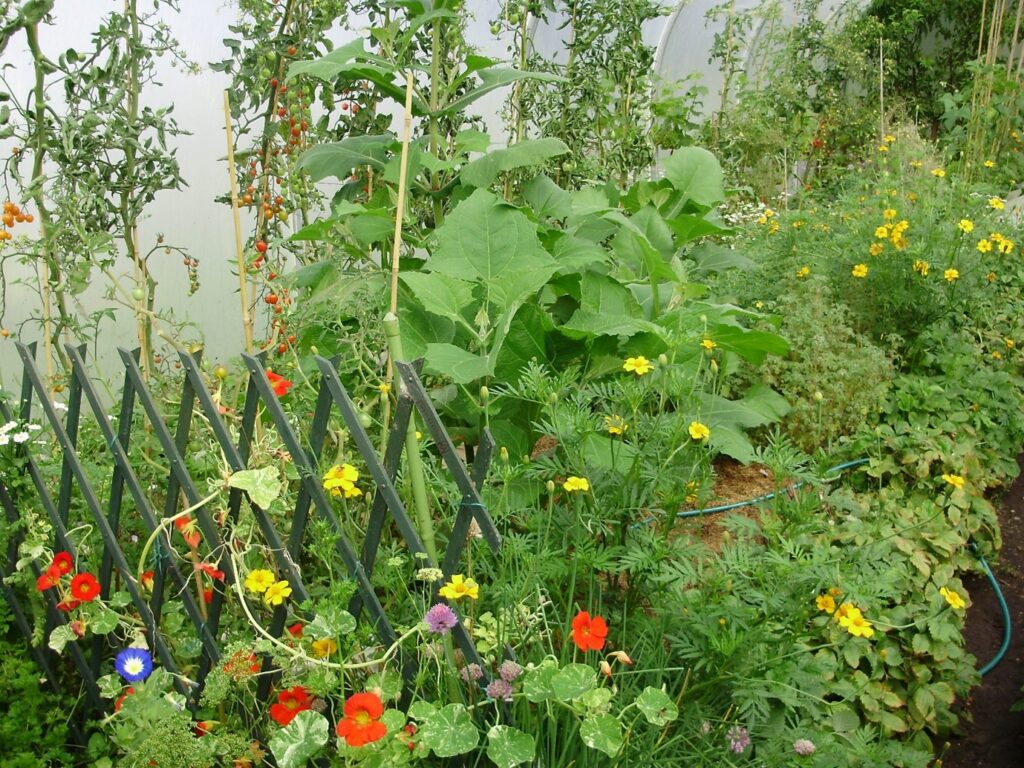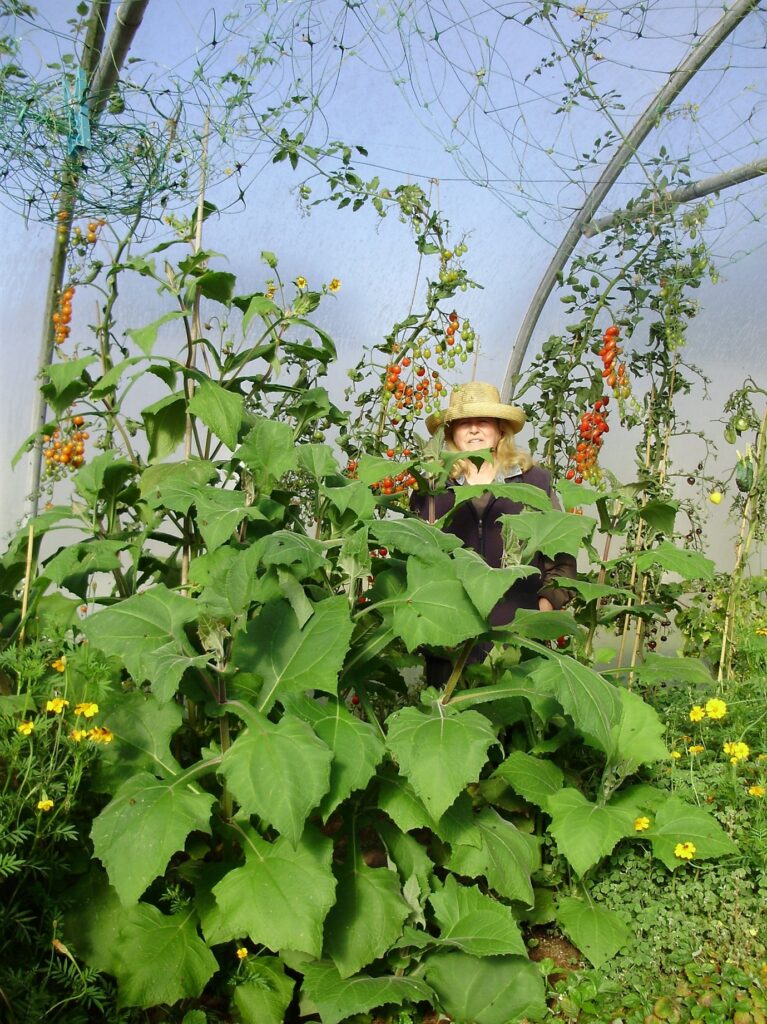“Remember – always sow the seeds. You can catch up on everything else – but if you get behind on doing that, then there’s nothing you can do about it.” ….. (A great piece of advice I was given many years ago)


Sorry to mention this, although it’s not yet quite midsummer – but it’s now time to think ahead to what crops you will want to grow over the winter, in the polytunnel or outside, and buy the seeds now if you haven’t done so already! If you don’t, they may disappear off the shelves, when garden centres re-organise their stock for the autumn season which they tend to do before the end of June. Online seed companies may also be sold out of popular varieties by then.
If you buy open-pollinated seed, rather than F1 hybrids – you can then save seeds from them, as I do with many vegetables, and that will be a small step along the road to growing your own food security. If you haven’t saved seed before – just try it, and you’ll be hooked forever! I gloat over mine and feel like a satisfied Squirrel when looking through my stash of home-saved seeds on the long winter evenings!
There’s still time to sow many crops in gentle warmth now in pots or modules, for late summer and autumn tunnel/greenhouse cropping:
French beans (dwarf and climbing), edamame (soy) beans, sweet corn, courgettes, pumpkins, summer squashes, marrows and melons, as they are all fast-growing. You can also still sow cucumbers & gherkins (Restina, and Foothills Grape are all excellent gherkins or half-sized varieties for pickling or salads) for late summer and early autumn cropping, also calabrese/Italian broccoli (Green Magic is good) and self-blanching celery for later autumn crops. If you don’t have tomato plants but want to grow some, then bush tomato Maskotka is a fast-developer which is always reliably early. If sown in early June, it will reliably crop in September.
Propagators and areas where you are raising young seedlings should be shaded from strong sun at all times now and make sure to turn off the propagators during the day, if it’s warm enough. The temperature can rise dramatically in greenhouses and tunnels at this time of year, and if it’s too hot – things can quite literally cook! Also remember to fill up spaces between plants in propagators with some sort of insulation like bubble wrap. This stops bare areas losing heat, stops overheating and prevent energy waste. I save even tiny pieces of bubble wrap that come in any packaging for this use.
Although in theory you could sow everything outside now – the weather is so erratic and the nights can still be quite chilly, so it’s still worth sowing tender crops like French and runner beans, sweetcorn, basil, cucumbers, melons, pumpkins and squashes in pots or modules in a greenhouse, polytunnel or propagator for planting outside in 2 – 3 weeks. These need reliable warmth and will germinate far more quickly undercover – often in 2-3 days – making them at least a week to 10 days earlier than anything you might sow now outside. If the weather turns very wet and cold, seeds can rot when half germinated. There have been many nights here recently when the temperature here has gone down to only 5 degrees Centigrade!
Sowing in modules also avoids potential losses through slug damage, leather jackets and other pests – and it helps you to make better use of valuable growing space.
Sow some quick growing annuals now directly into the tunnel soil in odd corners and also among crops to attract bees, hoverflies and other beneficial insects which will help control pests and provide pollination. These and other flowers in return provide the insects with vital pollen and nectar.
It’s also it’s time to start thinking about the slower developing winter tunnel crops. Self-blanching celery for winter tunnel cropping needs to be sown in cool conditions around mid – late June, for tunnel planting later, as it is quite slow to germinate, and is a slow developer at first.
Outdoors, sow in modules, in a seedbed for transplanting, or in situ where they are to crop:
Amaranth (callaloo), beetroot, carrots, cabbages (leafy non-hearting and late stone head types), peas (early varieties such as Kelvedon Wonder from now to ensure cropping before early autumn frosts), calabrese and ‘tenderstem’ broccoli, Brocoli Raab/rapini, courgettes, squashes & marrows, ‘Witloof’ chicory and Radicchio (for winter forcing), endives, salad onions, Florence fennel, French and runner beans, leeks (an early var. for baby leeks), land cress, lettuces, perilla, orach, kohl rabi, kales (early June for winter cropping), radishes, rocket, Swiss chards, spinach, summer squashes, sweet corn, white turnips and swedes, summer purslane, lamb’s lettuce, salad mixes, soft herbs such as basil, oregano, parsley, coriander, dill, fennel etc. and perennial hardy herbs including sorrel.
Also sow some single, fast growing, annual flowers to attract beneficial insects like hoverflies to help with pest control, and bees to help with crop pollination. Plants like limnanthes (poached egg flower), calendula, Californian poppies, convulvulus tricolour, buckwheat, nasturtiums, phacelia, sunflowers etc.
Sow fast-growing green manures like buckwheat, red clover, mustard Caliente (a brassica so be careful of rotations) and phacelia, to improve the soil, ‘lock-up’ carbon and feed worms (after digging in), on any empty patches of ground that won’t be used for 6 weeks or more, or which needs improving. Red clover, buckwheat and phacelia in particular are also great for bees! (You can ‘bulk buy’ raw buckwheat seed very cheaply from your local health food shop – just don’t get ‘roasted’ buckwheat – it obviously won’t germinate!!)
In warm, well-drained soils outside, tubers of Oca, Mashua, Sweet Potatoes and Yacon can all be planted now
All of these will produce a better crop in a polytunnel, particularly in Ireland, as they like warm soil, bulk up late, and are vulnerable to wet weather and autumn frosts. They also prefer well-drained conditions. With Yacon – you plant the small baby ‘growing’ tubers that cluster round the stem area at the top of the larger tubers. These are fast-growing plants which all need a long growing season as they only begin forming their tubers in late autumn – in colder frost prone areas growing them in a greenhouse or tunnel is the best way to get a reliable crop. Do keep in mind though, that Yacon plants eventually need a LOT of space! The photos below were taken only a month apart in August and September – quite a difference!

